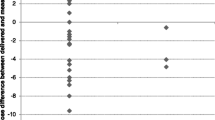Abstract
Dosimetry for intraoperative radiotherapy (IORT) after wide local excision for breast cancer using a 50 kV X-ray needle (Intrabeam) was performed in vivo using thermoluminescence dosimetry. Eight LiF:Mg,Ti chips were placed on the skin around the incision site after wide local excision while the tumour bed was irradiated to a prescribed dose of 5 Gy 10 mm from the applicator surface. The maximum and mean measured skin dose for 57 patients ranged from 0.64 to 7.1 Gy and 0.56 to 4.78 Gy, respectively, reflecting different tissue thicknesses overlying the applicator. The average maximum dose of 2.93 ± 1.46 Gy was below the threshold for severe radiation skin toxicity.



Similar content being viewed by others
References
Dinsmore M, Harte K, Sliski A, Nomikos P, Dalterio MJ, Npp A, Loenard W, Oettinger P, Yanch J (1996) A new miniature X-Ray device for interstitial radiosurgery: device description. Med Phys 23:45–52
Beatty J, Biggs PJ, Gall K, Okunieff P, Pardo FS (1996) A new miniature X-Ray device for interstitial radiosurgery: dosimetry. Med Phys 23:53–62
Ebert M, Caruthers B (2003) Dosimetric characteristics of a low kV-intra-operative X-ray source: implications for use in a clinical trial for treatment of low-risk breast cancer. Med Phys 30(9):2424–2431
International Commission on Radiation Units and Measurements (1976) Determination of absorbed dose in a patient irradiated by beams of x or gamma rays in radiotherapy procedures. ICRU report 24. ICRU, Bethesda
Kron T, Butson M, Hunt F, Denham J (1996) TLD extrapolation for skin dose determination in vivo. Radiother Oncol 41:119–123
Kron T, Elliot A, Wong T, Showell G, Clubb B, Metcalfe P (1993) X-ray surface dose measurements using TLD extrapolation. Med Phys 20(3):703–711
Toivonen MJ (1983) Elimination of error sources in TLD by using an automatic post reading calibration procedure for each measurement. Radiat Prot Dosimetry 6:79–82
International Atomic Energy Agency (2000) Absorbed dose determination in external beam radiotherapy, IAEA Technical report series N398. IAEA, Vienna
Geleijns J, Wondergem J (2005) X-ray imaging and the skin: radiation biology, patient dosimetry and observed effects. Radiat Prot Dosimetry 114:121–125
Sadeghi A, Prestidge B, Lee JM, Rosenthal A (2006) Evaluation of the surface radiation dose and dose gradient in early stage breast cancer using high dose rate brachytherapy MammoSite applicator. Brachytherapy 5:230–234
Author information
Authors and Affiliations
Corresponding author
Rights and permissions
About this article
Cite this article
Fogg, P., Das, K.R., Kron, T. et al. Thermoluminescence dosimetry for skin dose assessment during intraoperative radiotherapy for early breast cancer. Australas Phys Eng Sci Med 33, 211–214 (2010). https://doi.org/10.1007/s13246-010-0019-3
Received:
Accepted:
Published:
Issue Date:
DOI: https://doi.org/10.1007/s13246-010-0019-3




